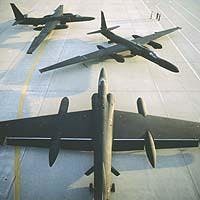U-2 reconnaissance aircraft upgrade involves new cockpit displays and avionics computer
by John McHale
PALMDALE, Calif. — Engineers at Lockheed Martin Aeronautics Co. in Palmdale, Calif., are upgrading the 1960s-vintage cockpit avionics on the venerable U-2S reconnaissance aircraft with three 6-by-8-inch multifunction displays, an up-front control and display unit, and an independent secondary flight display system.
Lockheed Martin Astronautics recently delivered the first U-2S reconnaissance aircraft to the 9th Reconnaissance Wing based at Beale Air Force Base, Calif.
The U-2S Reconnaissance Avionics Maintainability Program (RAMP) replaces the legacy systems in an original 26 units that are no longer supportable, and which provide improved pilot situational awareness, says Bryan Swords, project manager for the U-2S avionics upgrade at Lockheed Martin Aeronautics.
The entire fleet of 31 U-2S models and four two-cockpit trainers will be modified — six a year — by 2007, Swords says. The upgraded version, the U-2S is expected to last 20 to 30 years, he says.
The U-2 continues to fly intelligence-collection operations for the U.S. — including those in support of Operational Enduring Freedom in Afghanistan, Lockheed Martin officials say.
"The bottom line in any modernization effort is support to the war fighter," says U.S. Air Force Lt. Col. Mike Masucci, U-2 flight test commander. "With this first RAMP delivery, the U-2 pilot now has superior situational awareness and improved survivability. This increases collection efficiency which leads directly to more bombs on target and reduced risk to friendly forces."
The RAMP technology also improves the mean-time-between-failure of the avionics from one failure every 47 flight hours to one every 810 flight hours, Swords says.
RAMP uses commercial off-the-shelf equipment, some of which is modified to meet the special needs of the high-altitude U-2S aircraft, Swords says. For example, the avionics processor is repackaged to fit into the U-2, he adds.
The new liquid crystal multifunction displays are from L-3 Communications Display Systems in Alfereda, Ga., using glass from Phillips Digital in Kobe, Japan, Swords says. The displays are ruggedized for shock and vibration.
The new cockpit avionics, installed under the RAMP program, bring digital technology to the U-2.
The new displays replace the 1960s analog gauges with high-performance graphical displays, Swords says. The displays also give the pilot a better view of the ground whereas in the old cockpit he had to look into a large tube in the center of the cockpit, Swords says.
Honeywell Grimes in Urbana, Ohio, designed the up-front control and display unit; engineers at Meggit Electronics in England produced the independent secondary flight display system, Swords says. The warning/caution device is from by Korry Electronics in Seattle, he adds.
The RAMP head-forward controls replace existing radio controls, which had been located on the left side-panel aft of the pilot and awkward to reach in flight. This helps reduce pilot workload, which is already heavy during a 10-hour flight, Swords says.
A new main avionics processor receives signals that currently drive the old instruments and then digitize, process, and output information to various smart multifunction displays. The processor is a PowerPC 603e running on a SP103 rugged single-board computer from the Lockheed Martin Systems Integration Aerospace division in Owego, N.Y., Swords says. The RAMP databus is 1553 and the hard drive has a capacity of 18 gigabytes, he adds.
The processor also uses an Ethernet card to download after-mission flight information to a laptop on the ground, Swords says. The operating system is VxWorks from Wind River Systems in Alameda, Calif.
Other systems that were added include Identification Friend or Foe, UHF/VHF, and an Integrated Landing System, Swords says.



